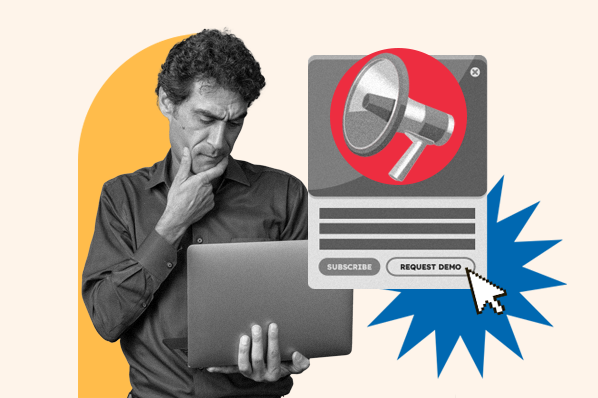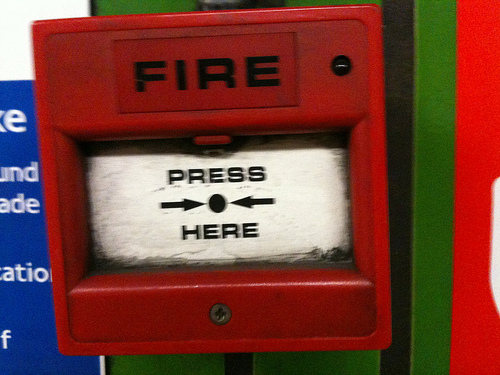Chocolate or vanilla? Comedy or drama? Heels or flats? People love options. After all, they don't say "variety is the spice of life" for nothin'! So why not transfer this common knowledge about people's love for options over to your marketing and give your visitors and prospects some choices, too?
While there are quite a few ways in which you can offer variety in your marketing, today we're going to zone in on one in particular: secondary calls-to-action (CTAs).
Start generating more conversions from your calls-to-action today with HubSpot's free marketing tools.
So let's discuss exactly what secondary CTAs are, and why you should be using them in your various marketing initiatives.
What Is a Secondary CTA?
Why -- I'm so glad you asked! A secondary CTA is a call-to-action that provides an alternative conversion opportunity or action to the primary action you ideally want visitors, prospects, or leads to take. Your secondary CTA is generally featured less prominently than your primary CTA, and it can be a great way to further engage and capture people who may not find the offer in your primary call-to-action appealing.
For example, your primary call-to-action might be for visitors to download one of your educational ebooks, which they have to complete a full lead-capture form in order to redeem. And as a secondary call-to-action, you might ask visitors to subscribe to your blog by email, which requires just their email address. Now think about those people who may opt to subscribe to your blog because either they A) weren't interested in the subject of your ebook or B) just weren't ready to provide more personal information than just their email address. If you hadn't offered that secondary conversion opportunity, those people may have moved on from your website without taking any action at all! But because you did, while you may not have captured them as a lead, per say, they're now a subscriber to your blog. So they'll likely come back to read more of your content, and hey -- maybe one of your other primary CTAs will tickle their fancy next time.
In other words, secondary CTAs can be a great tool for saving some of those lost conversion opportunities.
Why Are Secondary CTAs Beneficial?
In addition to saving lost conversion opportunities, secondary CTAs can be beneficial for a slew of other reasons ...
1) They're Great for Generating Reconversions
In general, the primary CTA you choose should align with the person's position in the sales funnel. For example, if someone is already a lead who has converted on a bunch of your top-of-the-funnel offers like educational ebooks, your primary CTA might be for a more middle-of-the-funnel offer such as a product demo. But maybe someone isn't ready to take that next step to see a demo, and they're content in their current stage -- still craving that purely educational ebook you're promoting in your secondary CTA. No problemo! Even if that reconversion isn't elevating the status of your lead, it doesn't mean it's not valuable. For one thing, that lead is still engaging with your content, and when you use marketing software technology like smart fields and progressive profiling, each and every conversion enables you to gather even more information and intelligence about that lead that you can use to craft more personalized lead nurturing campaigns for them as a result.
2) They're Great for Progressing Leads to the Next Stage
On the other hand, let's say you're sending an email to a segment of your contacts database who are all just newly converted leads. They've only converted on one of your offers, so it's probably too soon in the game to promote your product demo as your primary CTA. So you decide to promote an intermediate-level offer related to the subject matter of the introductory-level offer they first converted on. But as your secondary CTA, you also point to the landing page for your product demo, and -- whaddya know! -- some of those contacts just so happen to go for the product demo anyway!
Let's be honest: You can do your very best to align your offers to a person's stage in the sales cycle, but you can never truly know when a given person is ready to take the next step. By giving leads the secondary option of progressing further even when you think they're not ready, it's a win-win!
3) They Help You Prioritize and Support Additional Business Goals Other Than Just Lead Generation
Keep in mind that your CTAs don't have to always be encouraging conversion on a landing page. A call-to-action is just that ... a call to action. In other words, maybe you're trying to grow your social reach, so you decide to use your secondary CTA to encourage people to follow you on Twitter, Facebook, or LinkedIn. Or maybe, because you know how social sharing impacts things like SEO, you choose to use your secondary CTA to encourage people to share the blog post they just read in social media. Or maybe your company's annual event is coming up, and you're trying to attract more attendees, so you decide to use your secondary CTA to promote that event. Or, on the flip side of that same coin, maybe event registration is your top priority right now, you want to make that the focus of your primary CTA, but so as not to sacrifice lead generation, you make your lead gen offer your secondary CTA. The point here is, utilizing both a primary and secondary CTA enables you to prioritize and balance your goals, lead generation or otherwise.
Best Practices to Consider When Choosing Secondary CTAs
A secondary CTA can promote just about anything a primary CTA can -- an ebook download, a webinar signup, a social media follow or share, an event registration, a blog subscription, a consultation request, a trial, a coupon -- and the list goes on. The important thing to remember about secondary CTAs is that the offer you choose for your secondary CTA should depend heavily on context. Here are some contextual considerations to make when you're either choosing the offer for your secondary CTA or deciding on its look, feel, or positioning.
1) Determine Your Goals
Like we just we talked about, your decision about what to use as your secondary CTA will largely depend on what your individual goals are, so it's important to determine what those are first and foremost. This may also vary based on the goals of your primary CTA, where your secondary CTA is getting placed, and what the goals of that particular channel are. For example, it might make sense to promote your annual conference as a primary CTA on your website's homepage, with secondary CTAs supporting lead generation. But the same might not hold true for your email marketing messages, whose main goal may be lead generation.
2) Don't Compete With Your Primary CTA -- Complement It
Remember: Your primary CTA should encourage the most desired action you want people to take. Considering that, you want your secondary CTA to complement that primary one, not compete with it. So make sure your secondary CTA -- from copy, to design, to size, to placement -- doesn't ever overpower your primary CTA in any way. It should be immediately evident to your audience what your desired course of action from them is. Otherwise, you might lose out on conversions from your primary CTA for secondary conversions, and chances are, you don't want that.
3) Take the Person's Lifecycle Stage Into Consideration
We talked briefly about this earlier, but it's worth mentioning again. Always keep the person's stage in the sales cycle in mind during your secondary CTA selection. If your primary CTA is encouraging them to take the next step and move further down the sales funnel, it may be wise to use your secondary CTA to promote something a little bit less commitment-inducing and more in-line with their current position in the funnel in your secondary CTA.
Furthermore, certain pages of your website are likely aligned with certain likely stages in your sales cycle. It makes sense that someone visiting your pricing page, for example, might be further along in the sales funnel than someone checking out your "About" page. Adjust your primary and secondary CTAs accordingly. Dynamic, or Smart CTAs can an additional layer of complexity and relevance here, since they allow you to automatically display certain CTAs based on what you already know a persona's lifecycle stage is.
4) Take the Visitor's Interests Into Consideration
Similarly, the person's interests can also play a big role in your choice of secondary CTAs. For instance, let's say you're a plumber, and you're sending an email to a segment of your leads who have already downloaded your introductory ebook on plumbing basics. Now let's say the primary CTA of this email is for a free call with one of your plumbing experts -- which would advance your leads to the next stage in your sales cycle. For your secondary CTA, you might choose to send them your intermediate ebook with some more detailed plumbing tips, knowing that they're interested in plumbing but may not be ready to talk to one of your experts. Maybe they're really confident in their ability to de-clog that sink drain themselves, and just aren't ready to admit that they need the help of professional ;-)
Smart CTA technology can help here, too, enabling you to display CTAs targeted at different interests by segmenting your CTAs based on page visit history, past downloads, etc.
5) Don't Overdo It
But you just told me, "variety is the spice of life!" Sure ... but there's a fine line between giving people choices, and overwhelming them with a million different options. While people like to have some level of control, they also crave direction. There's nothing worse than landing on a web page and being bombarded with a million different CTAs. It makes people freak out and think, Where do I go? What in the heck do you want me to do?! In general, try to stick to just one primary and one secondary CTA -- and in certain situations, it might also make sense to sprinkle the page or the email with some subtle things like social sharing/follow buttons. Just don't be all in your face about those if you're also promoting a primary and secondary CTA, too. Just use some good ol' fashioned good judgment.
6) Avoid Using Secondary CTAs on Landing Pages
With the exception of social sharing buttons, the only place we absolutely advise against ever using a secondary CTA is on your landing pages. If someone has arrived at one of your landing pages, they've already expressed interest in that landing page's offer by clicking through on some type of CTA -- whether it be a CTA on a blog post, web page, or in an email, a post shared in social media, or search result. The last thing you want to do is distract them by directing them somewhere else. Secondary CTAs on landing pages only create friction for the conversion process, so stick to the primary CTA of that landing page -- which is to fill out the form!
Examples of Secondary CTAs in Action
Let's round out this post by providing some examples of secondary CTAs in action! The following are examples from HubSpot's own marketing.
In Emails
The following email was sent to a relevant segment of our leads ...
Here's a breakdown of the CTAs within:
- Primary CTA: The primary CTA is promoting the primary purpose of this email send -- to encourage recipients to download our ebook, 16 Companies in 'Boring' Industries Creating Remarkable Content.
- Secondary CTA: The secondary CTA is in the P.S. of this email, promoting an inbound marketing assessment, which is a higher commitment offer that serves to further qualify and progress a lead through the funnel. As a result, recipients can either reconvert on the primary offer, or choose to take the next step in the sales cycle. Win-win!
- Social Share Buttons: While these can technically be considered secondary CTAs as well, and we generally advise just using one secondary CTA option, these buttons are subtle and don't compete with or take away from either the primary or secondary CTAs.
In Blog Posts
The following is an example of a primary and secondary CTA on one of the blog posts from this very blog. Let's take a closer look ...

- Primary CTA: Because we know that the majority of the traffic we get on this blog is new traffic, our primary CTA on this post, which is about blogging and content creation, is for a very top-of-the-funnel educational offer: a template to create your own blog editorial calendar.
- Secondary CTA: Because growing the reach of our blog is one of our goals, the secondary CTA promotes subscription to our blog.
These primary and secondary CTAs are much like the ones you see at the end of this very blog post. Of course, if you're already a lead in our database, you may be seeing a Smart CTA for a more middle-of-the-funnel offer as the primary CTA (wink wink).
As with anything in marketing, the best way to know which secondary CTAs work best for you in each channel is to test them! So put on your lab coat and safety goggles, and get experimenting!
Calls to Action






![28 CTA Templates to Design Clickable CTAs in PowerPoint [Download]](https://53.fs1.hubspotusercontent-na1.net/hubfs/53/cta-template.jpg)
![How to Add Slide-In Calls-to-Action to Your Blog Posts [Tutorial]](https://53.fs1.hubspotusercontent-na1.net/hubfs/53/Slide-in_CTAs.webp)
